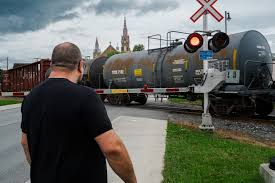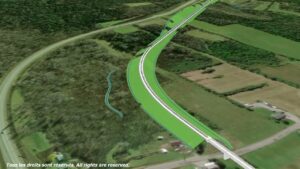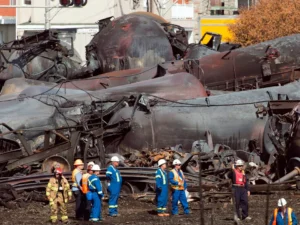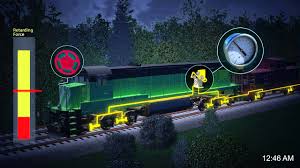Witness Describing Accident:
Witnesses recalled observing the train passing
through the crossing at an excessive speed with no locomotive lights,
“infernal” noise and sparks being emitted from the wheels. It was
also stated by witnesses that since the train was going so fast, the flashing
lights or bells on the crossing signals did not activate.
Gilles Fluet, a Musi-Café patron who was leaving the site just before the derailment, said the wheels were emitting much white smoke. The runaway train passed 50 meters (160-ft) behind him moving at highway speed. Travelling with no signals, the train jumped the track, sending a river of burning oil into the lake.

“It was moving at a hellish speed … no lights, no signals, nothing at all. There was
no warning. It was a black blob that came out of nowhere. I realized they were
oil tankers, and they were going to blow up, so I yelled that to my friends,
and I got out of there. If we had stayed where we were, we would have been
roasted.” The unmanned train derailed in downtown Lac-Mégantic at 01:14,
in an area near the level crossing where the rail line crosses Frontenac
Street, the town’s main street.
Location of Accident:
This location is approximately 600 meters
(2,000 ft) northwest of the railway bridge over the Chaudière River and is also
immediately north of the town’s central business district. People on the
terrace at Musi-Café—a bar located next to the center of the explosions—saw the
tank cars leave the track and fled as a blanket of oil generated a ball of fire
three times the height of the downtown buildings.

Between four and six explosions were reported initially as tank cars ruptured and crude oil escaped along the train’s trajectory. Heat from the fires was felt as far as 2 kilometers (1.2 mi) away. People jumped from the third floor of buildings in
the central business district to escape the fire. As the blazing oil flowed
over the ground, it entered the town’s storm sewer and emerged as huge fires
towering from other storm sewer drains, manholes, and even chimneys and
basements of buildings in the area.
The Musi-Café tavern owner says that some
employees and patrons felt the tremors of the train and thought it was an
earthquake. They went out and started running. Other patrons and employees told some survivors that the tremors were an earthquake and that it would be better to stay under a table. Of those who went out, not all survived.
Some were not able to outrun a “tsunami of fire”. No boiling-liquid expanding-vapor explosion (BLEVE) occurred, according to the official investigation report, as
no fragments were projected from the damaged tank cars.
AfterMath of Incident:
The 5 locomotives and the VB car were found intact, separated from the rest
of the train, outside the central part of town, still on track, but far from
the crash scene. The 6-car lead group had apparently decoupled from the rest of
the train, continued rolling down the track, crossed the river bridge,
travelled through a sharp right bend, and came to rest about 1 kilometer (0.62
mi) southwest of the derailment site (45°34′8″N 70°53′20″W).

The equipment that derailed included 63 of the 72 tank cars as well as the buffer car. Nine tank cars at the rear of the train remained on the track and did not explode.
emergency responders took them away from the derailment site while the fire was still burning. Almost all of the derailed tank cars were damaged, many having
large breaches. About six million liters of petroleum crude oil were quickly
released; the fire began almost immediately.
Around 150 firefighters were deployed to the scene, described as looking
like a “war zone”. Some were called in from as far away as the city
of Sherbrooke, Quebec, and as many as eight trucks carrying 30 firefighters
were dispatched from Franklin County, Maine, United States (Chesterville,
Eustis, Farmington, New Vineyard, Phillips, Rangeley and Strong). The fire was
contained and prevented from spreading further in the early afternoon. The
local hospital went to Code Orange, anticipating a high number of casualties
and requesting reinforcements from other medical centers, but they received no
seriously injured patients.
Volunteer interviewed:
A Canadian Red Cross volunteer said in interview that there were
“no wounded. They’re all dead”. One off-duty Musi-Café cook, Bernard
Théberge, was on the terrace at the time of the derailment and was treated for
second-degree burns to one arm. The hospital was later used to shelter dozens
of seniors who had been evacuated. Approximately 1,000 people were evacuated
initially after the derailment, explosions, and fires. Another 1,000 people
were evacuated later during the day because of toxic fumes.

Some took refuge in an emergency shelter established by the Red Cross in a
local high school. According to initial claims made by the railway, the
engineer who left the train unattended went to the explosion zone and uncoupled the last 9 undamaged tank cars that were still on the tracks at the end of the derailment.
After uncoupling the tank cars, he used a rail car mover to pull
them away from the derailment site. This version of events has been disputed by
Lac-Mégantic’s fire chief, who indicated that a volunteer firefighter had used
a rail car mover borrowed from a local factory to remove these cars from
danger. It was later revealed that two employees of Tafisa (Serge Morin,
Sylvain Grégoire), a firefighter (Benoît Héon), the MMA engineer (Tom Harding)
and a member of the family-owned excavation company Lafontaine and Son (Pascal-Lafontaine) had worked to move 9 tank cars away from the fire.
Tafisa, a local particle board industry that moves much of its product by rail, has a rail car mover which has the capability to deactivate the brakes on the cars it tows.
Morin, aided by his colleague Grégoire, used the rail car mover to move the
first 5 tank cars away from the fire. When they could not find a level crossing
to move the rail car mover back to the disaster site, they used a loader to
remove another 4 tank cars, 2 at a time. Because the loader lacked equipment to
deactivate railcar brakes, Harding told the men to use the loader to break the
air lines on cars to release the air brakes on each of these four cars.
Lafontaine’s workers hauled gravel to the site, created firebreaks and blocked
manholes as burning oil spread into the town’s storm sewer system.
